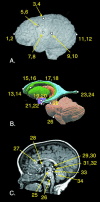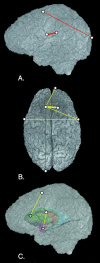Central nervous system phenotypes in craniosynostosis
- PMID: 12171474
- PMCID: PMC1570892
- DOI: 10.1046/j.1469-7580.2002.00074.x
Central nervous system phenotypes in craniosynostosis
Abstract
Though reduction in the number of cranial elements through loss of a suture is a recognized trend in vertebrate evolution, the premature closure of cranial sutures in humans, craniosynostosis, is considered a pathological condition. Previous research on craniosynostosis has focused primarily on the skeletal phenotype, but the intimate relationship between the developing central nervous system (CNS) and skull is well documented. We investigate the morphology of the CNS in patients with isolated craniosynostosis through an analysis of cortical and subcortical features using 3-D magnetic resonance images (MRI). Results show that a distinct CNS phenotype can be defined for specific diagnostic categories. Many differences in CNS morphology observed in the patient samples may be anticipated based on skeletal morphology, but others are not reflected in the skull. We propose a developmental approach to determining the cause of premature suture fusion, which includes investigation of the craniofacial complex as a system, rather than study of isolated tissues.
Figures





References
-
- Aboitiz F. Does bigger mean better? Evolutionary determinants of brain size and structure. Brain Behav. Evol. 1996;47:225–245. - PubMed
-
- Aldridge K, Barta PE, Pearlson GD, Richtsmeier JT. Brain morphology, MRI data, and landmark-based analyses of form. Am. J. Phys. Anthropol. Suppl. 2000;30:94. (abstract)
-
- Aldridge K, Marsh JL, Perlyn C, Richtsmeier JT. Quantification of central nervous system dysmorphology in isolated craniosynostoses. Fifty-Eighth Annual Meeting of the American Cleft Palate–Craniofacial Association, Minneapolis, MN. 2001. (abstract)
-
- Aylward EH, Augustine AM, Li Q, Barta PE, Pearlson GD. Measurement of frontal lobe Volume on magnetic resonance imaging scans. Psychiatry Res. 1997;75:23–30. - PubMed
-
- Barta PE, Dhingra L, Royall R, Schwartz E. Improving stereological estimates for the Volume of structures identified in three-dimensional arrays of spatial data. J. Neurosci. Meth. 1997;75:111–118. - PubMed
Publication types
MeSH terms
Grants and funding
LinkOut - more resources
Full Text Sources
Medical

